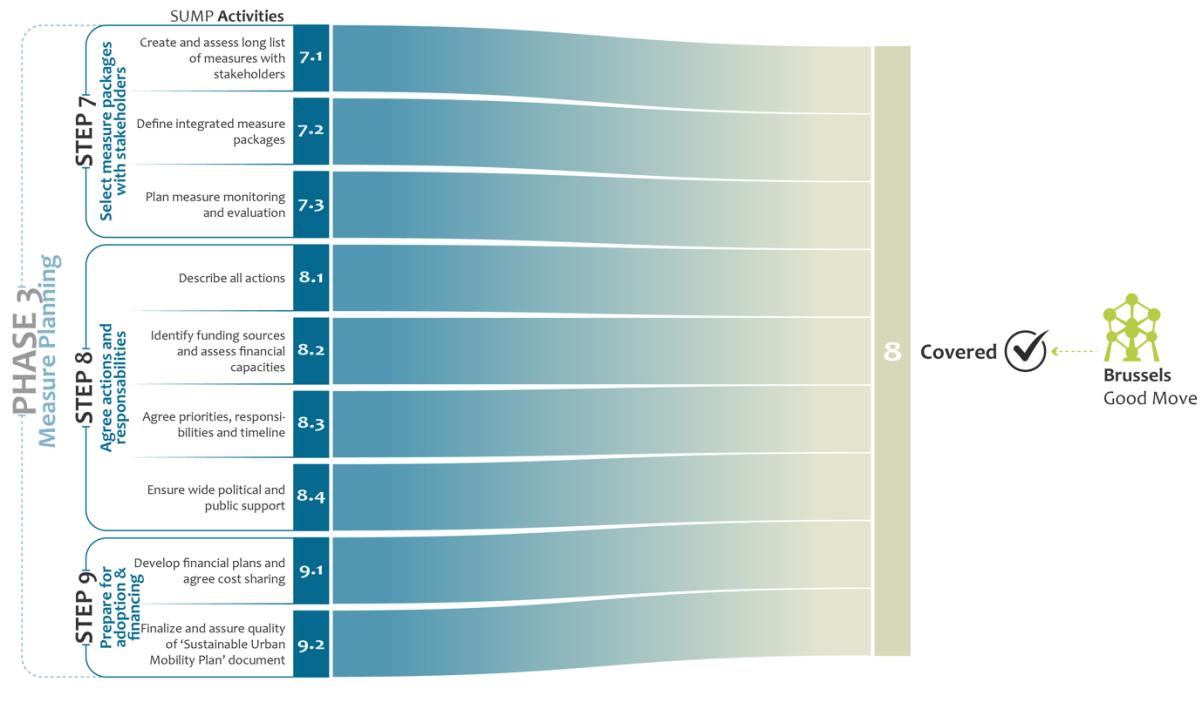
4 minute read
Figure 47
Convergence Phase) to guarantee their operability especially in the cross-cutting areas and also provide transparency around the planned actions, which also contributes to assuring political and public support, as suggested by the SUMP guidelines.
Step 9 prepare for adoption and financing: GM has allocated budget information in each action, apart from also presenting a chapter dedicated to budgetary information, which is called (in English, Budgetary and human resources reflecting the ambitions). This chapter has explained some technical information regarding budgetary reallocations and funding sources. In addition, it has also shared the main budgets regarding the settlements from 2017. Further, to conclude this Step and ensure t the (in English, The Public Inquiry) about the draft document that happened for four months in 2019. Moreover, an extensive communication system has been organized with presentations, press articles, poster campaigns, social media, temporary exhibitions, and emblematic events. In the end, there were a total of 40 meetings, including 22 at the core of the municipalities, which enabled participants to discuss the draft plan directly. Thence, the last activity has also been successful, and Figure 47 compiles the GM analyses from SUMP Cycle Phase 3, where all activities have been covered.
Advertisement
Figure 47. Overview of Brussels Phase 3 analyses. Source: Author
Thus, by finishing Step 9, GM has achieved the third and most important milestone the with an outstanding performance. If Brussels manages to implement the majority of the measures proposed by GM, it would genuinely change the mobility behavior patterns in the city.
4.2.4. Phase 4 | Implementation & Monitoring
GM has presented implementation and monitoring processes throughout the document, especially in (in English, General Part), on the subchapters , presenting some previous achievements, and also in the stratégique, where it shared some management and monitoring strategies for implementation. Therefore, the three steps from the SUMP cycle Phase 4, Implementation & Monitoring, have been explored in the analyses below.
Step 10 manage implementation: GM has stated in the subchapter (in English, The conditions for success) the need for cooperation between the municipalities to implement the proposed measures. In addition, it has also mentioned some contractual desires and addresses some partnership challenges, such as local and regional actors involvement in redeveloping public spaces. Moreover, GM has pointed out that some actions require implementing coordination with federal entities or other regions. Hence, to ensure this coordination, achieve concrete results, and guarantee the monitoring of long-term actions, a desire has been expressed to establish a Conseil Métropolitain de la Mobilité (CMM in English, Metropolitan Mobility Council) to tackle and manage many actions in broader scales.
Additionally, GM s actions have been set out in the management contracts and investment plans of public operators, as well as in the operational and budgetary programs of the public bodies and partners. Furthermore, public tenders management is under the supervision of the Region, and they are following the regional mobility plan (GM), i.e., STIB, parking management, and Brussel Port contracts. Thus, it could be seen that GB has presented much important information regarding the implementation management and the procurement processes, as recommended by the SUMP guidelines.
Step 11 monitor, adapt and communicate: GM has mentioned that based on monitoring dashboards, Bruxelles Mobilité draws the attention of political decision-makers to the
desirable adaptations of the operational and budgetary programs concerned to ensure the indicators for each action makes it possible to assess their implementation in terms of resources and achievements. Hence, the monitoring phase is the subject of a brief annual report, where the programmatic and budgetary adaptations decided to allow the execution of the actions are highlighted there, as well as the blocking points of the actions insufficiently carried out (Bruxelles Mobilité, 2020b). Although GM has shown to be aligned with the SUMP guidelines in terms of monitoring progress and informing the achieved results through an annual report, it has not mentioned how it intends to engage citizens and stakeholders along this process. Hence, it should be something to consider to be added since it can increase the ownership and ensure public support, consequently Step 12 review and learn lessons: GM, aligned with the SUMP guidelines, has presented the results and lessons learned from the previous plans in the introduction part, as has already been mentioned in the analysis of Step 3. This Step is crucial to identify the strengths and weaknesses of the previous plans in order to address new challenges and solutions. Thus, it is also expected that for the following plan, Brussels will keep analyzing its successes and failures as it successfully has done for GM, sharing the outcomes and, most importantly, the lessons acquired from what did not happen as expected. By doing this, it will be possible to have an overall impact on the implemented measures and explore new challenges and solutions for the region. Hence, Figure 48 displays the summary of the GM analyses from SUMP Cycle Phase 4, in which almost all activities have been covered (six in total), and only one activity has been partially covered.
n of the SUMP cycle with the fourth and last milestone measure implementation evaluated and the establishment of a new cycle. Thus, it is well known that Brussels has followed many SUMP guidelines to create its current plan. However, it is time to put into practice and hopefully detach the association of being the (in English, capital of immobility) from its image.










